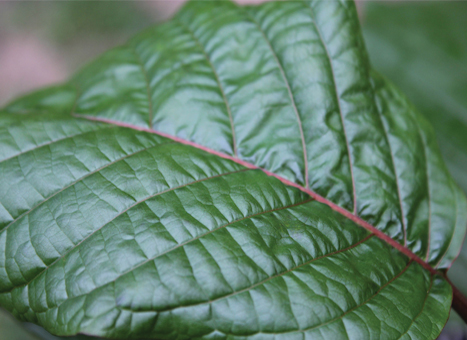Branches bursting with secrets
While mitragynine, 7-hydroxymitragynine and a few dozen other alkaloids make up the bulk of the 57 phytochemicals that have been isolated from kratom leaves, the plants contain a panoply of currently unidentified compounds and metabolites.
“The average plant leaf is somewhere between 35,000 and 50,000 distinct phytochemicals, and we really can identify about 1,000 if we’re lucky,” says Susan Murch, a chemist at the University of British Columbia. “You’re looking at a minimum 34,000 unknowns. In your glass of merlot, you’re looking at 7,000 unknowns; in your cup of coffee, over about 6,800 unknowns.”
 The leaf of Mitragyna speciosa contains at least 34,000 unknown phytochemicals.thorporre/Wikimedia Commons
The leaf of Mitragyna speciosa contains at least 34,000 unknown phytochemicals.thorporre/Wikimedia Commons
Identifying these unknown compounds and mapping their enzymatic relationships to one another by use of mathematical equations is known as metabolomics; each study can take up to three to four years due to its scale. “You do a very small mass spec analysis, and then you spend a year mining data. It’s a massive bioinformatics program,” says Murch.
Murch recently published a literature review in the Journal of Ethnopharmacology that detailed the history and chemistry of kratom and its sister species in Western medical literature with Web of Science, Google Scholar, the Royal Museum for Central Africa, the Internet Archive, the Hathi Trust and the Biodiversity Heritage Library.
Murch and her collaborator Paula N. Brown are hoping to get a metabolomics study involving kratom up and going within the next few years. “There are no metabolomics studies out there that really are definitive in terms of the different varieties, the different strains, the different things people are using,” she says.
Identifying the thousands of unknown metabolites, or intermediary components, within kratom leaves will be essential to understanding how the plant products are differently processed by populations across the globe.
“Kratom is traditionally used by a fairly specific population of Vietnam, Thailand and Southeast Asia, and so we don’t know about its nutrigenomics effects,” says Murch. “Assuming that a population in Southeast Asia will respond the same as a population anywhere else in the world is a bit of a leap of faith.”
Enjoy reading ASBMB Today?
Become a member to receive the print edition four times a year and the digital edition monthly.
Learn moreGet the latest from ASBMB Today
Enter your email address, and we’ll send you a weekly email with recent articles, interviews and more.
Latest in Science
Science highlights or most popular articles

Mining microbes for rare earth solutions
Joseph Cotruvo, Jr., will receive the ASBMB Mildred Cohn Young Investigator Award at the ASBMB Annual Meeting, March 7–10, just outside of Washington, D.C.

Fueling healthier aging, connecting metabolism stress and time
Biochemist Melanie McReynolds investigates how metabolism and stress shape the aging process. Her research on NAD+, a molecule central to cellular energy, reveals how maintaining its balance could promote healthier, longer lives.

Mapping proteins, one side chain at a time
Roland Dunbrack Jr. will receive the ASBMB DeLano Award for Computational Biosciences at the ASBMB Annual Meeting, March 7–10, just outside of Washington, D.C.

Exploring the link between lipids and longevity
Meng Wang will present her work on metabolism and aging at the ASBMB Annual Meeting, March 7-10, just outside of Washington, D.C.

Defining a ‘crucial gatekeeper’ of lipid metabolism
George Carman receives the Herbert Tabor Research Award at the ASBMB Annual Meeting, March 7–10, just outside of Washington, D.C.

The science of staying strong
Muscles power every movement, but they also tell the story of aging itself. Scientists are uncovering how strength fades, why some species resist it and what lifestyle and molecular clues could help preserve muscle health for life.

